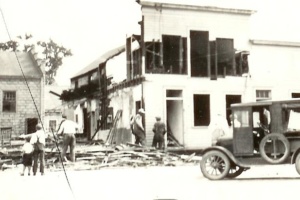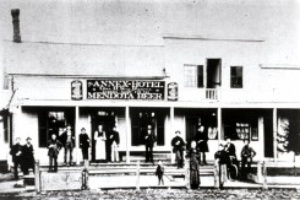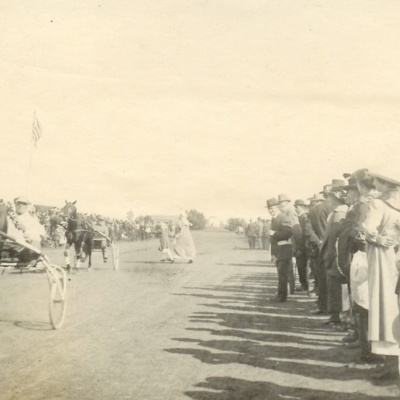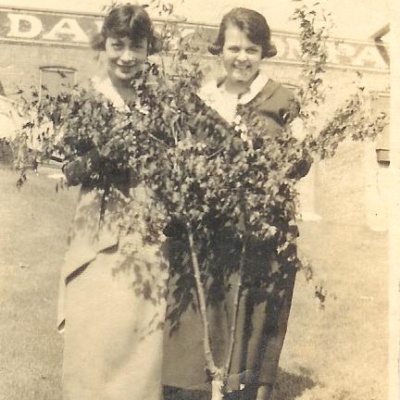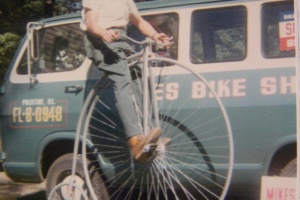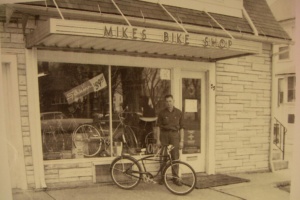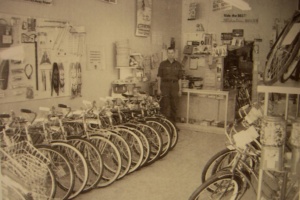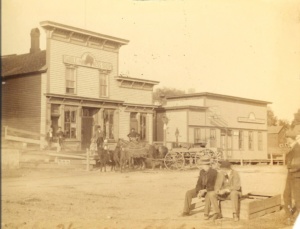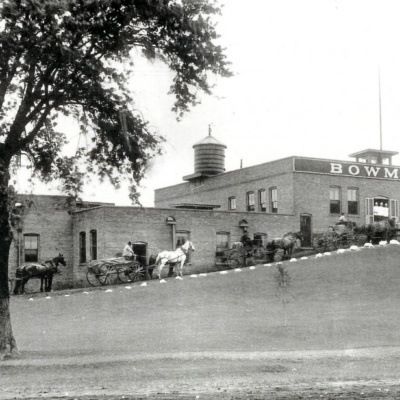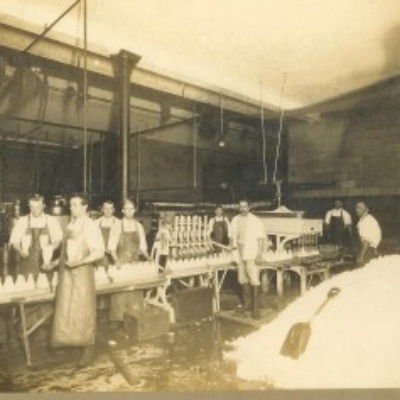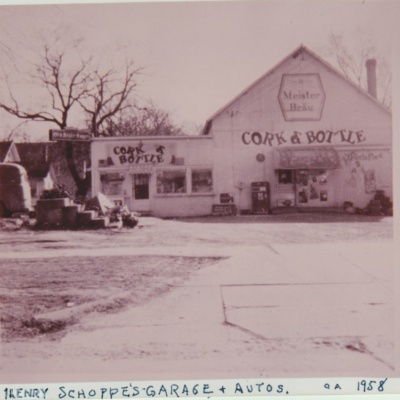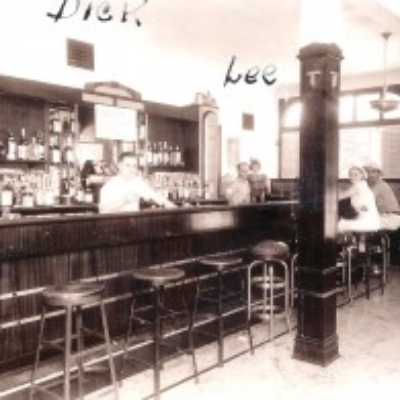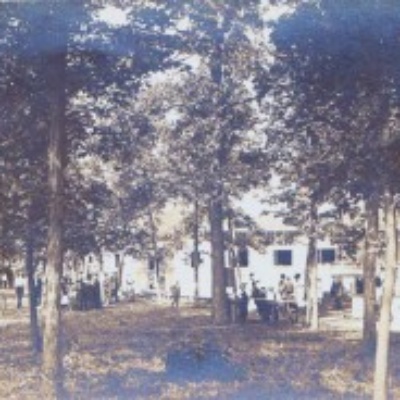Palatine Businesses
Annex Hotel
In 1870, Conrad Fink purchased a hotel and tavern at 45 West Slade Street. He moved here from Chicago with his family. Mr. Fink ran the tavern and Mrs. Fink cooked for the guests. The business prospered as travelers who came out from Chicago by train had to get off here and go to places like Wauconda by livery. Conrad died in 1875 and a year later Minnie married William Ahlgrimm. Mr. Ahlgrimm prided himself on being strict in the management of the hotel. He died in 1890 and Minnie retired from public life. She rented the hotel out for two years until her daughter, Minnie Fink, married Charlie Seip and the couple took over management of the hotel. Charlie ran the tavern while Minnie fed and roomed as many as 50 people a day. The price for three meals a day was 25 cents. A full meal from soup to dessert was served family style. Board cost three dollars a week. Salesmen who came through regularly often retained their rooms while they were gone. Minnie rose at 5 a. m. to bake bread, pies, and stews on the gas stove while overflow food was cooked on a wood burning stove. She specialized in oyster suppers for lodges and fed the Masons and the Athletic Club for years. The members of the Athletic Club were there so often that they renamed the hotel the Annex because it was next door to their club rooms at 33 West Slade Street. The Seips tore their old livery barn down in 1908 and a dance hall was built. When dances were held Mrs. Seip served supper in the basement. This hall later became the Palatine theater. With Prohibition and faster forms of travel business diminished. The hotel was sold in 1932 and torn down.
- Annex Hotel
- Annex Hotel
Brandt's Little Cafe
Brandt’s Little Cafe has been a favorite spot for area residents for many many years. Joe and Romelda Brandt opened the restaurant in Palatine in 1954 at 10 N. Northwest Highway. The business was moved to its current location at Northwest Highway and Quentin Road in 1969. The old location became The Pickwick House and later the Hob Nob Restaurant. The current building was originally a farmhouse in Inverness. It was built in 1883, and moved to its current location after a previous building, the Maple Grove Inn burned to the ground in 1930. In the 1950′s Nick and Al’s Friendly Inn occupied the building. The George Grisco family operated Brandt’s Little Cafe for years. New owners Walt Oswald and Jim Iuorio have done a fine job of renovating the business and recently enjoyed a grand re-opening.
Dean's Farm and Racetrack
Charley Dean was born in Palatine to Tim & Hannah Dean. His father was half owner of a general store here. Charley Dean had a way with horses from the beginning. His first job, in his teens, was driving a team of horses to a delivery wagon in Chicago. Later he was hired by a prominent livery stable operator, Chris Strassheim, to work in the Strassheim Stables. Strassheim had a strong interest in light harness horses, and had several in training at the old Ravenswood double oval on Chicago’s northwest side. He became so impressed with the manner in which his new employee handled the livery stock that he put Dean in charge of his training stable and taught him, how to train trotting horses.
Charley grew homesick, vowing to return to his birthplace for good. During the Chicago period, Dean came to the attention of business tycoon Thomas Boyle, a breeder and owner of Standardbreds. Boyle’s Lincoln Stock Farm was without a manager and trainer-driver. The farm’s location happened to be on the outskirts of Palatine and Dean signed on to manage the place that eventually became his own. He was soon courting Anna McMahon, and after a brief engagement the couple was married and moved to Lincoln Stock Farm. On August 2 of 1892 the first of the six Dean children was born and named Charles E. Dean, Jr. The following year daughter Hazel arrived. Then came Bess, Ben, Alene and Jerry.
Boyle’s Lincoln Stock Farm appeared ready to become one of the sport’s important owner-breeders. But Boyle was plagued by ill health and gradually decided to sell the farm and quit. Charley Dean quickly arranged to buy the place with a down payment and make it into his own private training and breeding establishment. Charley gradually improved the barns, paddocks and track until he had created a near-perfect setup for the training and breeding of horses. Located close to Chicago, owners from the city patronized Dean farm from the beginning. As the man from Palatine gained fame on the tracks of Illinois and neighboring states, horses began arriving from everywhere. Dean’s ability to pick an undeveloped animal and turn it into an ace performer produced a long list of champions and near champions, including Fleming Boy, Angiola, Collateral, Summer Song, Henry H. and such free-legged pacing marvels as Minor Heir, Tony Swift, and Empire Direct. Most of his great campaigners came to him unbroken. Others such as The Broncho, were broken over again and re-educated after being placed in Dean’s hands. An outlaw and a failure, The Broncho became a champion the very next year after joining the Dean stable. Perhaps Dean’s greatest achievement was the making of Minor Heir into the world champion green pacer and Fleming Boy into the world champion green trotting stallion in 1908.
Chase Dean, Charley’s oldest son, also a great harness racer, came back to Palatine in the 1960’s and spoke to a magazine writer, “Tree-shaded pastures, rolling hay fields once spread in every direction,” he continued. “It’s all gone, like a dream. Take our race track, for instance. They filled in the back stretch with asphalt a few summers ago and it’s now a busy four-lane avenue. A super-market stands where our main training barn was located; an insurance outfit erected a skyscraper on the spot where Ben’s shop stood . . . it was a fine blacksmith shop and Ben was proud of it. The old horse graveyard “thought it would remain forever” has disappeared. Covered with small look-alike houses, each with its trimmed hedges and manicured lawn, you wouldn’t believe that a select group of champion horses rest beneath the foundations, ghosts who rest beneath those cardboard dwellings “The Broncho, Colbert, May” — yes, even the great Star Pointer.
The Dean farm on the outskirts of Palatine was famed the world over as a training ground for stakewinners. Half-a-dozen assistant trainers and from 30 to 40 stablemen checked in annually at Dean farm for the winter and spring prep of sometimes as many as 80 horses. When they became old enough to handle the lines, Chase Dean and his younger brother Jerry, were their father’s chief lieutenants. Another son, Ben Dean, was an expert blacksmith and shod all the horses at the colony.
While horse training was the main activity at Dean farm, it was not the only one. One hundred tons of hay was baled each year on the 118 acres and on another nearby spread leased by the Deans. Enough oats and the straw that went with them were raised to supply the grain and bedding for both the track prospects and the 50 to 75 turnouts and broodmares that populated the paddocks and pastures.
Charles and Chase Dean are both in the harness racing Hall of Fame.
- Dean's Race Track
- Dean's Barn
- Ann & her daughter, Hazel, at Cook County Fair on their farm
Hunnerberg Hotel
This building was once the Kuebler/Hunnerberg Hotel. Joel Wood sold the land to Morgan Johnson in 1855; Johnson built a store on it. Michael Kuebler purchased the property from Morgan Johnson in 1867 for $1200. William Hunnerberg purchased it for $5,000 in 1879 indicating improvements. At the east end of the building, there was once a livery stable with a large hall upstairs. The building has not been changed greatly. The north porch along Wilson Street has been shortened. The tavern/restaurant was at the west end. An advertisement in an 1880’s newspaper said the hotel would serve dinner to passengers on the noon Chicago & Northwestern train. The hotel closed circa 1921 though the Hunnerburgs owned the property until 1941 when they sold it to Richard Sanford. Sanford was the proprietor of Dick’s Tavern at the corner of Wilson & Bothwell Streets. At various times there was an ice cream parlor, a doctor’s office, a restaurant, and a collectibles shop. In 1999, the building was remodeled and the Whistle Stop Cafe opened in the corner of the triangle. The cafe was sold in 2002 but remained open for three more years. In 2006, the Uptown Cafe opened in its place. It is now Dario’s serving the lunch crowd.
Jack's Old Mexico Inn
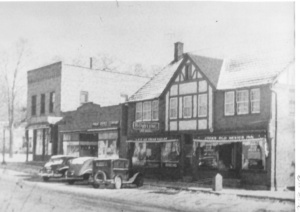
This spot once at 55 N. Bothwell was the Frye livery stable. Ira Frye came to Chicago from New York in 1863. Ira worked as a sheriff in Chicago and also drove a horse-drawn ambulance. In 1878 he moved to Palatine with his family. When Ira died in 1906, his son Fred took over the livery stable. Automobiles soon became more plentiful and the livery business closed. The next owner of this property was Charlie Dinse. He bought it in 1924 and added a brick facade to the front of the old stable. He ran a deli, barbershop, and a bowling alley there for years. The bowling alley was built about 1925 at the back of the building. Dinse sold the building in 1945. Jack Wilcox ran the place in this photo. It was a restaurant, ice cream parlor, and bowling alley. He took out the ice cream parlor and barber shop and added a cocktail lounge. His family lived on the second floor. In the mid 1950’s, he closed the bowling alley and restaurant and ran the place as a tavern. In 1972, the place was sold to a group of airline pilots and became Durty Nellie’s West Irish Pub. It was named after a real Durty Nellie’s pub in County Clare. For the next several years it had several different owners. Mark Dolezol took it over in 1988. The Bothwell location was purchased for the development of retail shops and condos and the new Durty Nellie’s opened on Smith Street in December of 2003. The building over 100 years old was torn down in February of 2004.
Kinsch Village Florist & Garden Center
The Kinsch family sold flowers in Palatine for eighty-five years. The three original greenhouses, formerly located at 301 W. Johnson St., Palatine, go back further yet. The greenhouses were built in 1923 by Hugh Aspinwall of the Palatine Floral Company. Mr. Aspinwall sold hyacinths, narcissus, Easter lilies and chrysanthemums. What delighted his customers the most was a flower called the sweet pea as attested by the slogan “Particular People Prefer Palatine Peas.” Aspinwall, a fine tenor, sold the business four years later to Walter Schinkowsky and became an announcer and singer on the radio.
Schinkowsky’s mortgage with First National Bank of Palatine was pocketed by former president and prominent Palatine attorney Ralph Peck. This ruined the bank and sent Mr. Peck off to Leavenworth. The Palatine Floral Co. property was put up for auction. In 1938 Valentine Kinsch, a florist of Rogers Park, Chicago, put in the winning bid of $4,500 for the property and moved into the house across the street at 316 W. Johnson St. with his wife Mary and their five children Leo, Edward, Catherine, Lorraine and Marion. Schinkowsky built a new greenhouse to the west.
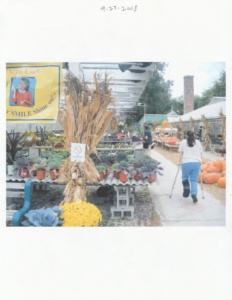 The Kinsch family was one of several that had Luxembourg roots. Others were the Pesches of Des Plaines, the Leiders of Buffalo Grove and the Geimers of Long Grove. The Kinschs specialized in growing and selling carnations to the wholesale trade. In 1956 the family opened Kinsch’s Flower & Gift Shop to the public and began selling corsages, potted plants and planters. By 1961 it was advertising lilies, table arrangements and hydrangeas. In 1971 the family opened a nursery and garden center. The family built a bridge across Salt Creek in preparation for their first Autumn Fun Fest in 2004. The fest included a 35-foot trackless train that took children on a ride through a haunted forest. In later years the fest featured a corn maze and hay bale mountain.
The Kinsch family was one of several that had Luxembourg roots. Others were the Pesches of Des Plaines, the Leiders of Buffalo Grove and the Geimers of Long Grove. The Kinschs specialized in growing and selling carnations to the wholesale trade. In 1956 the family opened Kinsch’s Flower & Gift Shop to the public and began selling corsages, potted plants and planters. By 1961 it was advertising lilies, table arrangements and hydrangeas. In 1971 the family opened a nursery and garden center. The family built a bridge across Salt Creek in preparation for their first Autumn Fun Fest in 2004. The fest included a 35-foot trackless train that took children on a ride through a haunted forest. In later years the fest featured a corn maze and hay bale mountain.
In 2021 the property’s designation was suddenly changed from agricultural to commercial, raising the property tax bill from under $25,000 a year to $183,000. The Kinschs paid the bill but were forced to tear down all the buildings. In February, 2024 it was discovered that Cook County Assessor Fritz Kaegi’s office had made a mistake. The Kinschs are now trying to get a refund.
Lamplighter Inn
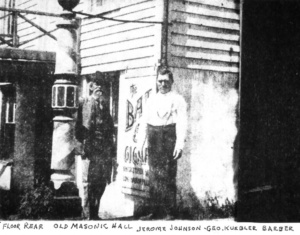
The historic building housing the Lamplighter Inn was built in the late 1850’s and originally had a first floor partly below grade level that was used as a meeting hall at times. At the rear, with an outside entrance was a barber shop owned by George Kuebler. The second floor, up a few steps from the ground, had a bakery and other shops later. The third floor, or present second, was a large meeting hall. The Masonic Lodge was organized there in 1859. The Masons purchased this top floor in 1885 and a few years later bought the whole building. Recent renovations upstairs brought the old Masonic star patterned ceiling paper to light.
During the Civil War and until 1868, school children attended classes here because the school building was not large enough for all students. In 1868, a new two story school was built on Wood Street. Immanuel Lutheran Church used the ground floor room while getting organized about 1870. The Methodist Church rented the top floor in 1868 while remodeling and again in 1895 while building a new brick church.
In 1904, the Masons moved to their new building at Palatine and Plum Grove Roads and sold this building to Charles Rappolt who had a bakery on the second floor. Later, the building was lowered eliminating the ground floor. During the 1930’s and 40’s Dick’s Tavern occupied the street level floor. The second floor was divided into two apartments. Dick’s was replaced by Mac & Al’s Tap and later by Lamplighter’s Inn.
The Matthei Store
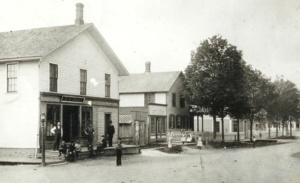
Henry Matthei was born in Germany and came to Chicago with his parents when he was seven years old. He first came to Palatine to visit his sister, Henrietta, who was married to Henry Schierding. In 1869, he entered into business with his brother-in-law. He eventually bought out his partner. This photo is of that first store on Brockway and Slade Streets. He built a new store at the southeast corner of Bothwell St. and Railroad Av. He married Emma Sutherland in 1871 and the couple had three children. They lived at 50 W. Wood Street. He was a Mason, an ardent Republican, served as postmaster for 16 years, and also served on the Board of Education. A few years before his death he turned over his store to his son, George, though he still went to the store daily. He died in 1926.
Mike's Bike Shop
Fred Mikes established Mikes Bike Shop in 1959. After high school, he was trained as a car mechanic, and during WWII, he was trained as an aircraft mechanic. Eventually, Fred’s mechanical abilities led him to open a bike shop. Fred hoped to open his own bike shop in Bensenville where he lived. When a business venture in his town did not work out, he met Mr. Gil Smith who was a part time police radio operator and an owner of a bike shop in Palatine. Gil was hoping to sell his bike shop, and Fred was looking to buy the shop. He bought the shop, and started the first Mikes Bike Shop located at 55 W. Wood St.
Customer service was Fred’s main priority from the start, and continues to be so for Fred’s son Wayne Mikes, the current owner. The name Mikes Bike Shop was a three-fold concept. First, Mikes is the family’s last name. Since Mikes rhymes with bikes, it fit naturally. Also, Fred’s wife Harriet always called Fred “Mike”. Harriet’s father and brother were both named Fred which caused a lot of confusion when all three were together.
Fred was very successful compared to Mr. Smith, but not to a level to support his family. Fred started to fix other things beside bikes, and his wife Harriet went to work to help the family.
By 1965 business improved, and Fred and Harriet decided to sell their house in Bensenville and buy a house in Palatine. Luck would have it that a building was for sale around the corner at 36 W. Wilson, Mikes second location. This new location had an apartment upstairs, which the Mikes Family moved into.
Fred’s son Wayne found bikes to be his passion. He bought the business from his father in 1979. Wayne moved Mikes Bike Shop to 155 N. Northwest Highway in November 1987 to increase the visibility of Mikes Bikes Shop.
- Fred Mikes, owner of bike shop
- Bike shop on Wood St.
- Inside Mike's Bike Shop
Uncle Andy's Cow Palace
Uncle Andy’s Cow Palace at the northeast corner of Quentin Road and Baldwin Road (Northwest Highway) has an interesting history. The land was originally owned by Elisha Pratt. It was sold to Edwin Converse whose family farmed it for over fifty years. Jack Deynzer purchased the farm in 1941 and five years later opened up a restaurant and cocktail lounge called the Radio Club Farm. Jack brought in mules for donkey baseball games to promote his new beverage, the “Moscow Mule”. Jack sold out in 1952 and the business became known variously as Paul Peterson’s Supper Club, Grier’s Supper Club and Evergreen Supper Club. An owner Oscar Craig was charged in 1958 with manslaughter in the death of manager Key Lverman but later cleared.
In 1964 Tom Speropulos and brothers Jim and George Bozikis purchased what was then known as Campbell’s Hearthstone and renamed it Uncle Andy’s Cow Palace. Uncle Andy was Andy Sellas who provided financial backing and encouragement. The Cow Palace featured many acts such as Jane Hyde, The Four Imperials, Joe Harris, and Bill LaBrose & his Orchestra.
In 1967 the owners installed a large statue of a cow and ran a contest to name it; “Andy’s Belle” won. When owner Tom Speropulos died in 1968, new management took over. John Bakos brought in fresh entertainment such as The Grecian Airs, The Volumes, The Tony Scott Trio and assorted belly dancers. Uncle Andy’s Cow Palace was succeeded by the La Romana Restaurant in 1978. The building burned down in 1981 and was replaced in 1987 by the Quentin Corners shopping center. The name Quentin Corners originally referred to a tiny community at Quentin Road and Rand Road.
Vehe Harness & Saddlery
Charles Vehe was born in Germany, the son of John & Margaret Vehe. He was still an infant when his family came to America and located in Palatine Township outside of the village. When he was 19, he began his apprenticeship as a saddler and harness maker in Chicago. In 1876, he started the harness shop near the corner of Brockway and Slade Streets. He carried a full line of saddlery and harness goods. He and his wife Caroline lived on Slade Street west of Brockway and belonged to the Union Evangelical Church.
Other Businesses . . .
- Bowman Diary
- Inside Bowman Dairy
- Cork & Bottle
- Dick's Tavern
- Deer Grove Park
